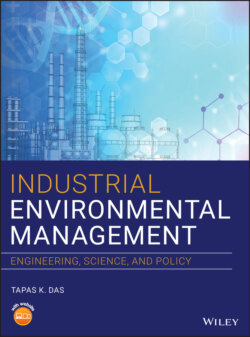Читать книгу Industrial Environmental Management - Tapas K. Das - Страница 161
2.15.1 Green Accounting Practices and Other Quality Manufacturing and Business Management Paradigms
ОглавлениеReaders familiar with various quality industrial management paradigms might have noticed that green accounting and capital budgeting practices are frequently compatible with general strategies for improving manufacturing and business management. These various strategies tend to work together to form a general philosophy of quality improvement; companies and industries that are accustomed to tracking and improving the productivity of labor and capital are just now realizing that it benefits them to do the same for energy and other resources. In quality management, many companies seek external certification of their management systems through ISO or similar organizations at a national level. More recently, ISO standards have been set for management practices.
ISO 9000 lays down guidelines of how to establish and operate an efficient quality assurance system, covering most aspects of a business and its procedures, and specifies that such procedures must be documented in a quality assurance manual (ISO 9000 2018a). How the system is implemented, managed, and periodically reviewed to ensure compliance and continued effectiveness also has to be clearly documented. Customers of any ISO 9000‐approved company should feel assured that they are buying from an organization that exercises tight control over its whole business, and the end product will be consistent with the declared specifications. ISO 9000 is a recognized business management standards for quality systems or assurances, and certification is fairly common now. To be certified, companies and businesses must show that they have the required quality management system (QMS) in place (see also Section 8.1).
ISO 14000 has also developed standards for environmental management. ISO environmental management standards are similar to ISO 9000 quality management standards except that they focus on environmental management, of which total cost accounting is a component. Note that ISO 14000 certification is based on whether or not a company has systems in place for managing environmental responsibilities, but not on environment performance. It does NOT require compliance with the regulations of the country in which the company is located. In some countries, it is possible that regulations may be more stringent than the standard. It seems likely, however, that in some companies achieving certification of adherence to the standard would improve the quality of environmental practices in that country. If, as expected, many countries adopt laws that require imported products to have been produced by companies certified to be adhering to ISO 140000, then environmental practices will almost certainly be improved worldwide (ISO 14000 2018b).
ISO 14000 describes in considerable detail what a company must do without prescribing how it must or can be accomplished. Examples of the some components of the ISO 14000 environmental management systems are as follows:
1 Environmental management principles
2 Environmental labeling
3 Environmental performance evaluation
4 Life cycle assessment
5 Principles of environmental auditing
6 Terms and definitions
The environmental management system (EMS) of ISO 14001 is part of the general management system that includes organizational structure, planning activities, responsibilities, practices, procedures, and resources for developing, implementing, achieving, reviewing, and maintaining the environmental policy of an organization. It is a structured process for the achievement of continual improvement related to environmental matters. The facility has the flexibility to define its boundaries and many choose to carry out this standard with respect to the entire organization or to focus the EMS on specific operating units or activities of the organization.
The EMS enables an organization to identify the significant environmental impacts that may have arisen or that may arise from the organization's past, existing, or planned activities, products, or services. It helps the organization to identify relevant environment, legislative, and regulatory requirements that may be imposed on it. Finally, the EMS helps in planning, monitoring, auditing, corrective action, and review activities to assure compliance with established policy and allows a company to be proactive in terms of meeting anticipated new standards and compliance objectives.
The following are the advantages and disadvantages of the ISO 14000 series:
